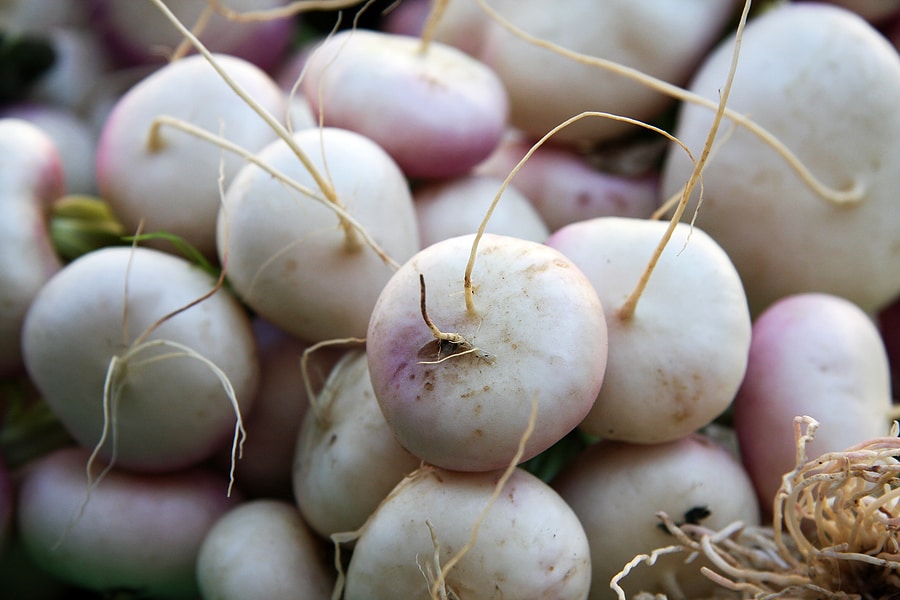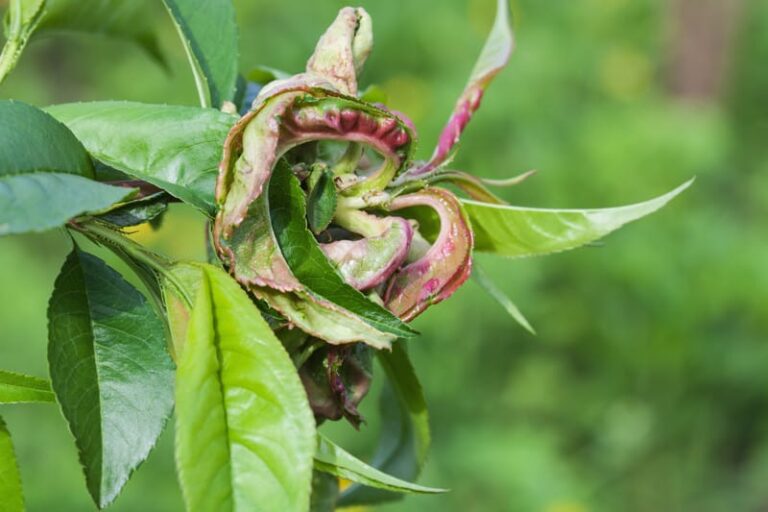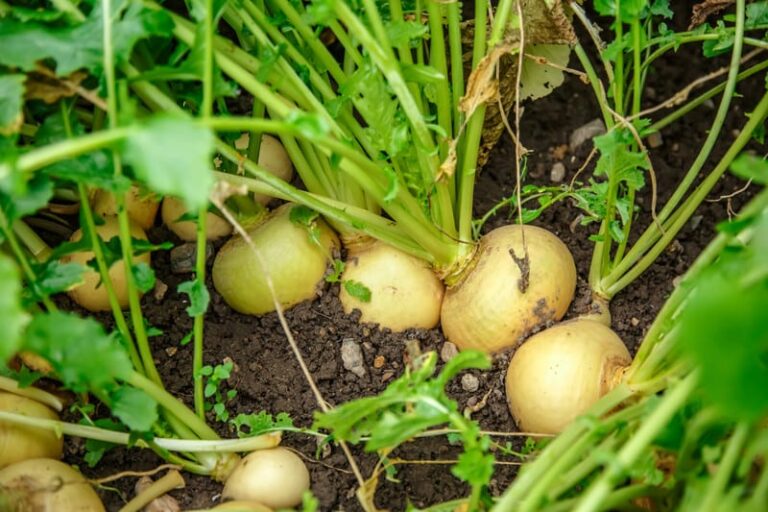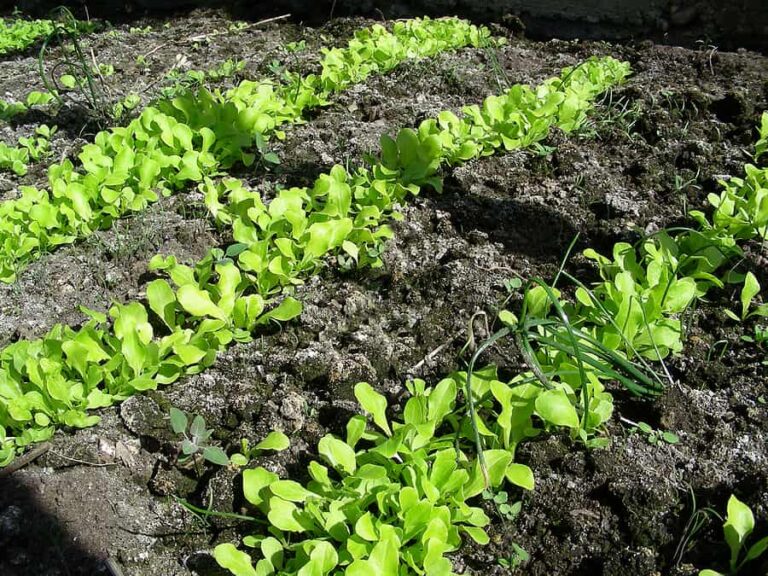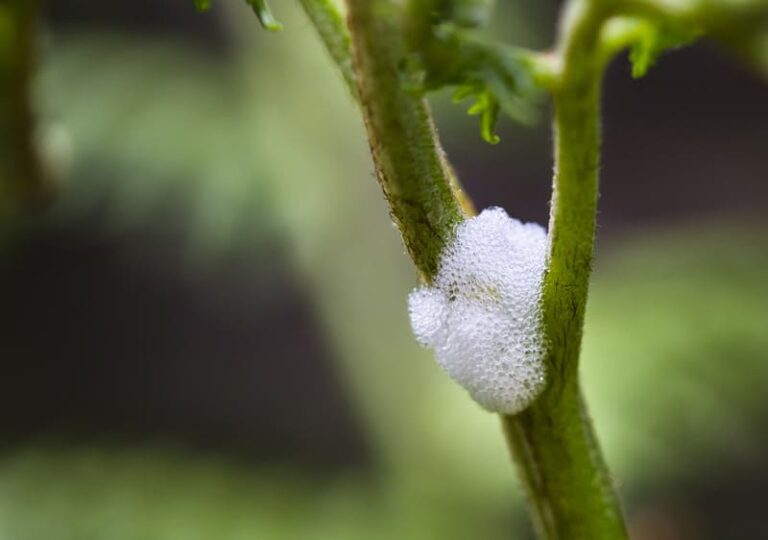Turnip, Rutabaga, Kohlrabi Growing Problems: Troubleshooting
Grow turnip, rutabaga, and kohlrabi in cool-weather. Get these vegetables started early in spring at least two months before the onset of very warm weather, or plant them in late summer so that they come to harvest in the cool days of autumn.
Grow turnips, rutabagas, and kohlrabi rapidly–these crops are most flavorful if they don’t linger in the garden. Thin these crops early to 2½ inches apart or more; they will suffer if crowded.
For turnip growing tips see Turnip Growing Success Tips at the bottom of this post.
Here are common turnip-growing problems with cures and controls:
Seed and seedling problems
Seeds rot or seedlings collapse with dark water-soaked stems as soon as they appear
Damping off is a fungus that lives in the soil, particularly where humidity is high. Do not plant in cold, moist soil. Make sure the soil is well drained.
Young plants are eaten or cut off near the soil level
Cutworms are gray grubs ½- to ¾-inch long that can be found curled under the soil. They chew stems, roots, and leaves. Place a 3-inch paper collar around the stem of the plant. Keep the garden free of weeds; sprinkle wood ash around the base of plants.
Seedlings fail to emerge from soil; seedlings are eaten; root surfaces tunneled or scared; plants wilt
A cabbage maggot is a small gray-white, legless worm to ⅓-inch long; an adult looks like a housefly. Flies lay eggs in the soil near the seedling or plant. Apply lime or wood ashes around the base of plants; time planting to avoid insect growth cycle. Plant a bit later when the weather is drier.
Tiny shot holes in the leaves of seedlings
Flea beetles are tiny bronze or black beetles a sixteenth of an inch long. They eat small holes in the leaves of seedlings and small transplants. The larvae feed on the roots of germinating plants. Spread diatomaceous earth around seedlings. Cultivate often to disrupt the life cycle. Keep the garden clean.
Leaf problems
Leaves curl under and become curled, deformed, and yellowish
Aphids are tiny, oval, and yellowish to greenish pear-shaped insects that colonize the undersides of leaves. They leave behind sticky excrement called honeydew which can turn into a black sooty mold. Use insecticidal soap. Cucumber, Squash
Leaves blotched white and yellow and deformed; leaves and plant wilts
Harlequin bug or stink bug. (1) Harlequin bug is shield-shaped usually black with bright red, yellow, or orange markings. Injury is caused by bugs sucking fluids from tissues. Hand-pick and destroy bugs and egg masses. Keep the garden clean of crop debris where bugs breed. (2) Stink bugs are gray or green shield-shaped bugs about ¼-inch long. Remove garden debris and weeds where bugs can overwinter. Hand-pick egg masses and bugs and destroy them.
Leaves yellow between veins; leaf margins brown and curl upward; stem base becomes dark brown, black, slimy, and rots
Blackleg is a fungal disease. Add organic matter to the planting bed; make sure the soil is well-drained. Remove infected plants and destroy infected roots. Rotate crops.
Yellow spots on leaves become water-soaked; spots become circular with gray centers
Leaf spot or Septoria leaf spot is a fungus disease. Plant disease-resistant varieties. Rotate crops. Keep the garden free of plant debris. Apply copper dust or liquid copper spray every 7 to 10 days.
Yellow spots on the outer leaves enlarge to become gray-brown streaks
Early blight or Cercospora leaf spot is a fungal disease spread by heavy rainfall and warm temperatures. Keep weeds down in the garden area; they harbor fungal spores. Avoid overhead watering.
Pale yellow-gray-brown, dark green spots on leaves
Fungal leaf spot. Add organic matter to the planting bed; make sure the soil is well-drained. Remove infected plants and destroy infected roots. Rotate crops.
Irregular yellowish to brownish spots on upper leaf surfaces; grayish powder or mold on undersides
Downy mildew is caused by a fungus. Improve air circulation. Plant disease-resistant varieties. Rotate crops. Keep the garden free of plant debris.
Leaves yellow and curl; stalks become twisted, brittle; plants yellow and are stunted
Aster yellows is a mycoplasma disease spread by leafhoppers. Remove infected plants. Control leafhopper. Keep the garden free of weeds which can harbor disease.
Leaves yellow, wilt; plant stunted; root gnarled and swollen
Clubroot is a fungal disease that leaves roots unable to take up water. Remove and destroy infected plants. Solarize soil. Make soil pH less acidic; add lime.
Leaves are eaten and plants are partially defoliated
Blister beetles are slender-bodied, gray, black, or metallic to ¾-inch long. Handpick beetles and destroy them. Keep the garden weeds and debris. Cultivate in spring to kill larvae and interrupt the life cycle. Spray or dust with Sevin or use a pyrethrum or rotenone spray.
Holes eaten in leaves, buds, or roots; some seedlings may be cut off at the soil level
Vegetable weevils or Colorado potato beetles. Vegetable weevils are gray to brownish with a V-shaped mark on the wings, but they do not fly. Larvae are greenish slug-worms to ¼-inch long. Dust plants with diatomaceous earth. Colorado potato beetles are yellow with black stripes on hard wing covers to ⅓-inch long. Larvae are red with black legs and heads and black spots on each side. Mulch deeply around plants; apply rotenone.
Irregular small holes eaten in leaves; seedlings may be eaten
Cabbage looper or armyworms. (1) Cabbage looper is a light green caterpillar with yellow stripes running down the back; loops as it walks. Keep the garden clean of debris where adult brownish night-flying moths can lay eggs. Cover plants with spun polyester to exclude moths. Pick loppers off by hand. Use Bacillus thuringiensis. Dust with Sevin or rotenone. (2) Armyworms are dark green caterpillars the larvae of a mottled gray moth with a wingspan of 1½ inches. Armyworms mass and eat leaves stems, and roots of many crops. Handpick caterpillars and destroy them. Cultivate after harvest to expose the pupae. Use commercial traps with floral lures.
Turnip, rutabaga, and kohlrabi growing success tips
Planting
Grow turnips, rutabagas, and kohlrabi in full sun. For summer-sown turnips, make sure the seedbed and seedlings are in the afternoon shade. These crops grow best in loose, well-drained soil rich in organic matter. Add aged compost to the planting bed before seeding and work it into the bed to a depth of about 6 inches.
Planting time
Sow turnips, rutabaga, and kohlrabi in the garden as early as 4 weeks before the last average frost date in spring. Sow succession crops every 2 to 3 weeks throughout the growing season. In hot summer regions, stop planting in early summer and then sow the fall crop in midsummer, about 8 to 10 weeks before the average date of the first frost in fall. In mild-winter regions, sow these crops every 2 to 3 weeks through the winter.
Care
Keep root crops evenly moist. Mulch turnips, rutabaga, and kohlrabi with aged compost to conserve soil moisture and keep the soil cool.
Harvest
Begin lifting turnips, rutabaga, and kohlrabi on about the date of maturity; mark your calendar at planting time. Check these crops on a regular basis and lift them as soon as they are ready to use. Salad turnips are ready when they are about 2 inches in diameter; storage turnips can stay in the ground longer as long as the soil remains cool. It is best to harvest spring-planted turnips young. Lift spring turnips as soon as the daytime temperatures average 80°F. Turnips for fall harvest can remain in the soil once temperatures begin to cool; cool temperatures will improve the flavor of fall harvest turnips. Follow the same guidelines to harvest rutabagas and kohlrabi.
Kohlrabi Growing Hub
Start here: The Ultimate Guide to Growing Kohlrabi: From Seed to Harvest
🌱 Planning & Varieties
- Best Kohlrabi Varieties to Grow in Your Garden – Compare early, late, and specialty varieties for flavor, color, and growth speed.
- When to Plant Kohlrabi: Seasonal Planting Guide – Spring, summer, and fall planting windows for cool, crisp bulbs.
- Kohlrabi Companion Planting: Best and Worst Neighbors – Plants that boost growth or deter pests naturally.
- Growing Kohlrabi in Containers and Small Spaces – Pot size, soil mix, and care for urban gardens.
🌿 Seed Starting & Transplanting
From seed to sturdy seedlings.
- Kohlrabi Seed Starting Tips – Germination tips, soil temperature, and timing for successful strong plants.
- How to Transplant Kohlrabi Seedlings Successfully – Hardening off, spacing, and planting depth for seedlings.
- Kohlrabi Spacing and Layout for Maximum Yield – Row vs. raised bed spacing, companion planting considerations.
🌾 Care & Maintenance
Tips for strong growth and pest-free plants.
- How to Water Kohlrabi for Healthy Growth – Deep watering, frequency, and tips for preventing bulb splitting.
- Fertilizing Kohlrabi: Tips for Bigger, Sweeter Bulbs – Organic and synthetic feeding strategies, nitrogen needs, and timing.
- Kohlrabi Care and Maintenance: Step-by-Step Guide – Mulching, thinning, pruning, and ongoing plant care tips.
- Common Kohlrabi Pests and Diseases and Natural Control Methods – Aphids, cabbage worms, clubroot, and preventive strategies.
🥗 Harvesting & Storing
Ensure top flavor and long-lasting storage.
- How to Harvest and Store Kohlrabi – Bulb size, leaf use, and storage timing.
🍽 Using Your Harvest
Inspired ways to enjoy their crop.
- Ten Ways to Cook and Serve Kohlrabi – How to prepare, cook, and enjoy kohlrabi leaves and bulbs.
Related articles:
Turnip articles on Harvest to Table:
How to Harvest and Store Turnips
Eight Ways to Cook and Serve Turnips
Three Ways to Cook Turnip Greens
Turnip, Rutabaga, and Kohlrabi Growing Problems Troubleshooting
Rutabaga articles at Harvest to Table:
How to Plant and Grow Rutabaga
How to Harvest and Store Rutabaga
Turnip, Rutabaga, Kohlrabi Growing Problems: Troubleshooting
More problem solver tips:

